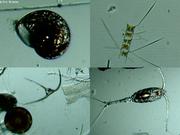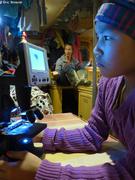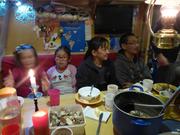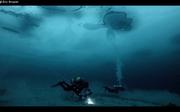Plankton
It was during summer 2005, on the East coast of Greenland, that Vagabond and her crew started looking more at plankton. Our mission was to plunge a net at regular intervals in the feeding area of little auks, close to a big colony on Liverpool Land. This bird, the largest in the Arctic, feeds mostly on plankton species that grow under the ice. The health of this little penguin is linked to the sea ice condition. Little auk becomes an indicator of climate change. Since then, we had many opportunities to stay in touch with plankton, to our delight. Each observation leads to discovery!
In December 2012, the Observatoire du Plancton has given us a small plankton net, while Océanopolis, provided us with a microscope. Back home, on board Vagabond, frozen in ice, we started to regularly send pictures of plankton living under the ice in winter in the Canadian Arctic. The more complicated is to make a hole large enough for the net, it's a good reason to join our friends Inuit hunters who catch seals with nets under the ice. We can use the existing holes. Back on board Vagabond, using our little microscope, hunters are stunned to find such a variety of creatures in their own garden!
As part of the GreenEdge project (2014-2016), we study the phytoplankton spring bloom in Qikiqtarjuaq (Nunavut, Canada ). Dozens of researchers, all kinds of sophisticated instruments, and even the Amundsen icebreaker are mobilized to analyze the phenomenon: the flowering of the ocean in spring! Inuit as much as bears, whales or seabirds are concerned by phytoplankton, at the origin of the main food web. GreenEdge offers an unprecedented opportunity for collaboration with the Inuit, who willingly share their knowledge and are curious about scientific discoveries.
Plankton also eat clams. Qikiqtarjuaq is probably the only community in Nunavut with local divers, digging for clams. To get samples of clams, sea urchins, algae... twice a month, diving under the ice for GreenEdge scientists, is an opportunity for us to share happy moments with our friends Inuit divers: it is all about science, collecting food and leisure. Diet and even the Inuit culture are closely linked to the health of plankton, and thus to climate change.




